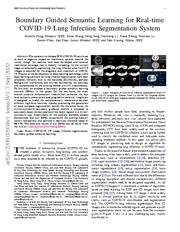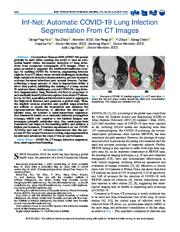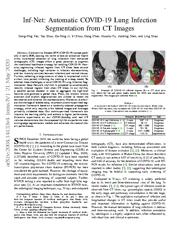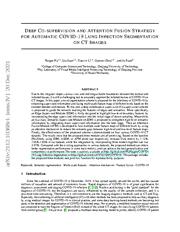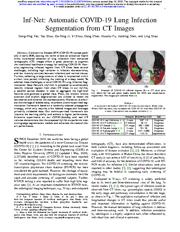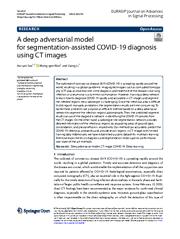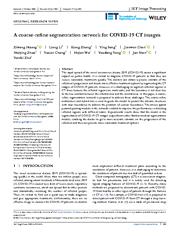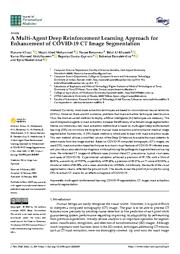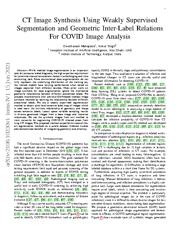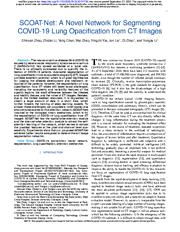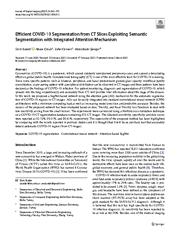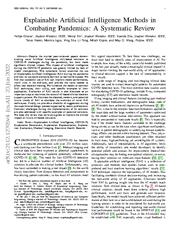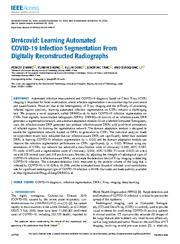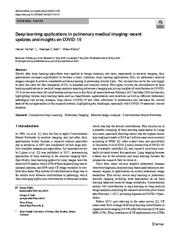A copy of this work was available on the public web and has been preserved in the Wayback Machine. The capture dates from 2022; you can also visit the original URL.
The file type is application/pdf.
Filters
Boundary Guided Semantic Learning for Real-time COVID-19 Lung Infection Segmentation System
[article]
2022
arXiv
pre-print
At the current stage, automatically segmenting the lung infection area from CT images is essential for the diagnosis and treatment of COVID-19. ...
Thanks to the development of deep learning technology, some deep learning solutions for lung infection segmentation have been proposed. ...
The major contributions are summarized as follows. 1) We propose an end-to-end boundary guided semantic learning method for accurate and real-time COVID-19 lung infection segmentation, which can be easily ...
arXiv:2209.02934v1
fatcat:z7c4c6yoqjg6ngggu5z5mowyby
Inf-Net: Automatic COVID-19 Lung Infection Segmentation from CT Images
2020
IEEE Transactions on Medical Imaging
Automated detection of lung infections from computed tomography (CT) images offers a great potential to augment the traditional healthcare strategy for tackling COVID-19. ...
To address these challenges, a novel COVID-19 Lung Infection Segmentation Deep Network (Inf-Net) is proposed to automatically identify infected regions from chest CT slices. ...
First, the Inf-Net focuses on lung infection segmentation for COVID-19 patients. ...
doi:10.1109/tmi.2020.2996645
pmid:32730213
fatcat:227q3yiporecdjxeixcj4jemhe
Inf-Net: Automatic COVID-19 Lung Infection Segmentation from CT Images
[article]
2020
arXiv
pre-print
Automated detection of lung infections from computed tomography (CT) images offers a great potential to augment the traditional healthcare strategy for tackling COVID-19. ...
To address these challenges, a novel COVID-19 Lung Infection Segmentation Deep Network (Inf-Net) is proposed to automatically identify infected regions from chest CT slices. ...
First, the Inf-Net focuses on lung infection segmentation for COVID-19 patients. ...
arXiv:2004.14133v4
fatcat:2mkxpdwi3bg3tdaqpifksucnie
Deep Co-supervision and Attention Fusion Strategy for Automatic COVID-19 Lung Infection Segmentation on CT Images
2021
Pattern Recognition
Due to the irregular shapes,various sizes and indistinguishable boundaries between the normal and infected tissues, it is still a challenging task to accurately segment the infected lesions of COVID-19 ...
In this paper, a novel segmentation scheme is proposed for the infections of COVID-19 by enhancing supervised information and fusing multi-scale feature maps of different levels based on the encoder-decoder ...
The joint
function can guide the network in learning the features of COVID-19 infections, thereby achieving a deep collaborative
supervision on edges and semantics. ...
doi:10.1016/j.patcog.2021.108452
pmid:34848897
pmcid:PMC8612757
fatcat:7pweaoclsbau7hskbcrtw2f3we
Inf-Net: Automatic COVID-19 Lung Infection Segmentation from CT Scans
[article]
2020
medRxiv
pre-print
Automated detection of lung infections from computed tomography (CT) images offers a great potential to augment the traditional healthcare strategy for tackling COVID-19. ...
To address these challenges, a novel COVID-19 Lung Infection Segmentation Deep Network (Inf-Net) is proposed to automatically identify infected regions from chest CT scans. ...
COVID-19 Patients Lungs [13] X-rays 70 / 28 Diagnosis COVID-19 Radiography [14] X-rays 219 / 2,686 Diagnosis COVID-19 CT Segmentation [9] CT image 110 / 0 Segmentation Recently, deep learning systems ...
doi:10.1101/2020.04.22.20074948
fatcat:i633vxx3knanjp3u6cabdngdwy
A Teacher-Student Framework with Fourier Augmentation for COVID-19 Infection Segmentation in CT Images
[article]
2022
arXiv
pre-print
In this paper, we propose a novel unsupervised method for COVID-19 infection segmentation that aims to learn the domain-invariant features from lung cancer and COVID-19 images to improve the generalization ...
Automatic segmentation of infected regions in computed tomography (CT) images is necessary for the initial diagnosis of COVID-19. ...
Meanwhile, few studies consider using lung cancer data which is easier to access, to boost the segmentation performance of COVID-19 infection. Semi-supervised Learning for Medical Segmentation. ...
arXiv:2110.06411v2
fatcat:zi3rduslynhcjkj3cnjpemh4bq
A deep adversarial model for segmentation-assisted COVID-19 diagnosis using CT images
2022
EURASIP Journal on Advances in Signal Processing
However, training a deep network to learn how to diagnose COVID-19 rapidly and accurately in CT images and segment the infected regions like a radiologist is challenging. ...
Additionally, we have established a public dataset for multitask learning. Extensive experiments on diagnosis and segmentation show superior performance over state-of-the-art methods. ...
We can achieve infection segmentation and COVID-19 classification at the same time. ...
doi:10.1186/s13634-022-00842-x
pmid:35194421
pmcid:PMC8830991
fatcat:ch3ryiu5i5cnrfakca4vmnxpwu
A coarse‐refine segmentation network for COVID‐19 CT images
2021
IET Image Processing
However, it is challenging to segment infected regions in CT slices because the infected regions are multi-scale, and the boundary is not clear due to the low contrast between the infected area and the ...
The coarse-refine architecture and hybrid loss is used to guide the model to predict the delicate structures with clear boundaries to address the problem of unclear boundaries. ...
For example, a COVID-Net [14] is proposed to detect patient with COVID-19 from CT through a deep learning method. Kamini et al. ...
doi:10.1049/ipr2.12278
pmid:34899976
pmcid:PMC8653356
fatcat:6zaej5xil5hzvjqtighlhif3v4
A Multi-Agent Deep Reinforcement Learning Approach for Enhancement of COVID-19 CT Image Segmentation
2022
Journal of Personalized Medicine
The results reveal the proof of principle for using DRL to extract CT masks for an effective diagnosis of COVID-19. ...
Based on COVID-19 computed tomography (CT) images, we used DRL mask extraction-based techniques to extract visual features of COVID-19 infected areas and provide an accurate clinical diagnosis while optimizing ...
For that, a multi-agent system (MAS) is qualified to learn mask extraction policies, in a deep reinforcement learning context, to reach optimal semantic segmentation of COVID-19 CT images. ...
doi:10.3390/jpm12020309
pmid:35207796
pmcid:PMC8880720
fatcat:3j4sievstjhtnlpnujxf3nftnm
CT Image Synthesis Using Weakly Supervised Segmentation and Geometric Inter-Label Relations For COVID Image Analysis
[article]
2021
arXiv
pre-print
We use the synthetic images from our method to train networks for segmenting COVID-19 infected areas from lung CT images. ...
While medical image segmentation is an important task for computer aided diagnosis, the high expertise requirement for pixelwise manual annotations makes it a challenging and time consuming task. ...
DL approaches have also been used for segmenting infection regions in lung CT [19] and for lung infection quantification [132] , [16] , [147] of COVID-19.
C. ...
arXiv:2106.10230v1
fatcat:ixbwn55egrcsnf4zeiqqinhuyq
SCOAT-Net: A Novel Network for Segmenting COVID-19 Lung Opacification from CT Images
[article]
2020
medRxiv
pre-print
There is no clinically automated tool to quantify the infection of COVID-19 patients. ...
To answer these challenges, we proposed a novel spatial and channel-wise coarse-to-fine attention network (CAT-Net) inspired by the biological vision mechanism, which is for the segmentation of COVID-19 ...
VB-Net [18] has a perfect effect on the segmentation of COVID-19 infection regions. ...
doi:10.1101/2020.09.23.20191726
fatcat:wixzc3gejfgwtos3diujsfjsd4
Efficient COVID-19 Segmentation from CT Slices Exploiting Semantic Segmentation with Integrated Attention Mechanism
2021
Journal of digital imaging
For patient monitoring, diagnosis and segmentation of COVID-19, which spreads into the lung, expeditiously and accurately from CT, will provide vital information about the stage of the disease. ...
-19 infection. ...
Kuloglu (MD), who is a radiologist in Lokman Hekim Hayat Hospital, for his valuable comments on the CT images. ...
doi:10.1007/s10278-021-00434-5
pmid:33674979
pmcid:PMC7935480
fatcat:ws3h5aqnyfbkfmrh2vqfmu7zim
Explainable Artificial Intelligence Methods in Combating Pandemics: A Systematic Review
[article]
2022
arXiv
pre-print
The impact of artificial intelligence during the COVID-19 pandemic was greatly limited by lack of model transparency. ...
Despite the myriad peer-reviewed papers demonstrating novel Artificial Intelligence (AI)-based solutions to COVID-19 challenges during the pandemic, few have made significant clinical impact. ...
Kristan Majors, for her support and guidance on search optimization for the PRISMA chart. We would like to thank Dr. ...
arXiv:2112.12705v4
fatcat:g44642qdnfchnmhgzsaqwjacua
DRR4Covid: Learning Automated COVID-19 Infection Segmentation from Digitally Reconstructed Radiographs
2020
IEEE Access
Automated infection measurement and COVID-19 diagnosis based on Chest X-ray (CXR) imaging is important for faster examination, where infection segmentation is an essential step for assessment and quantification ...
The estimated detection limit, measured by the percent volume of the lung that is infected by COVID-19, is 19.43% ± 16.29%, and the estimated lower bound of infected voxel contribution rate for significant ...
ACKNOWLEDGMENT The authors would like to thank providers of Radiopaedia, COVID-19 Image Data Collection, Chest X-Ray Images (pneumonia), SIRM, Twitter COVID-19 CXR dataset, and Hannover Medical School ...
doi:10.1109/access.2020.3038279
pmid:34812368
pmcid:PMC8545269
fatcat:qz7iij2t6bfnjbbjq66tl5bquq
Deep learning applications in pulmonary medical imaging: recent updates and insights on COVID-19
2020
Machine Vision and Applications
, and detection, as well as different pulmonary pathologies like airway diseases, lung cancer, COVID-19 and other infections. ...
Yet, coronavirus can be the real trigger to open the route for fast integration of DL in hospitals and medical centers. ...
clinical trials time to start putting all the Maths into real-time enforcement. ...
doi:10.1007/s00138-020-01101-5
pmid:32834523
pmcid:PMC7386599
fatcat:tkkylrptc5hkpoj52hjs3kuttu
« Previous
Showing results 1 — 15 out of 218 results

